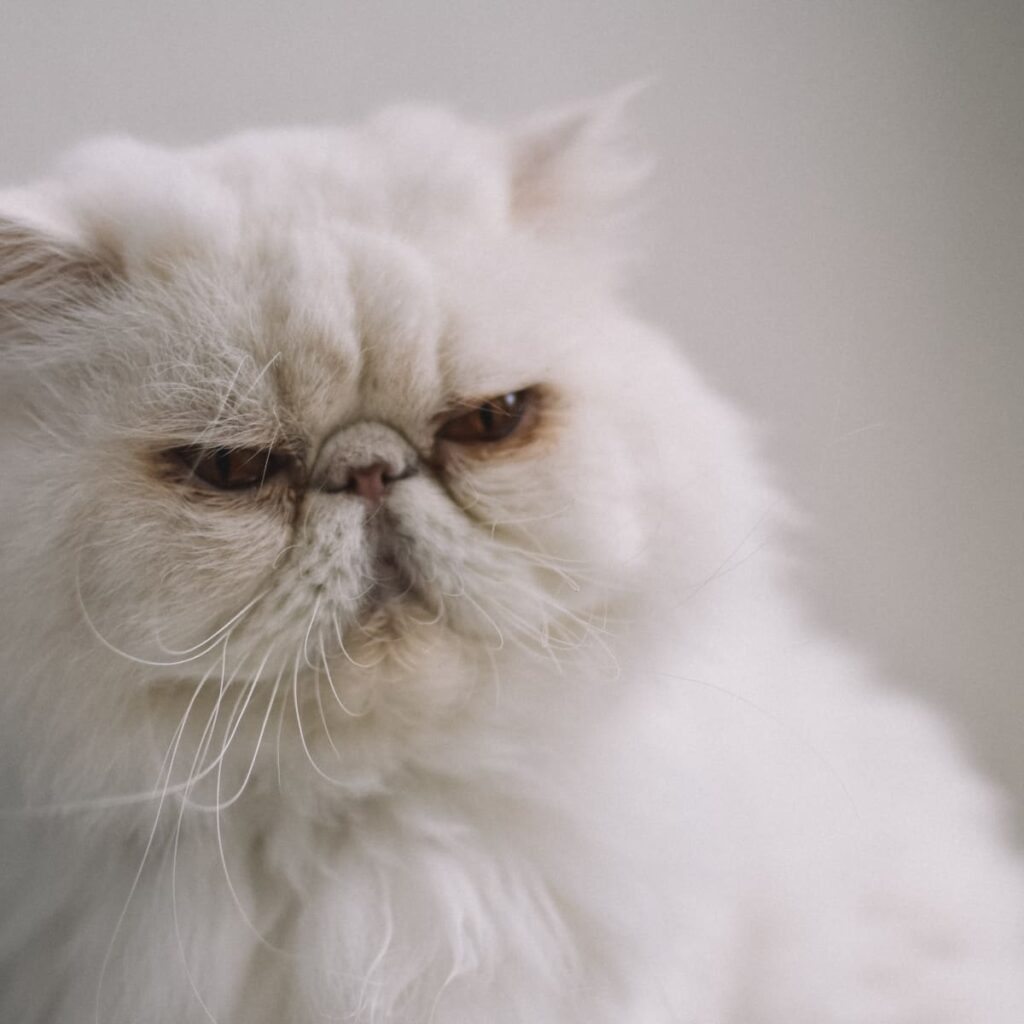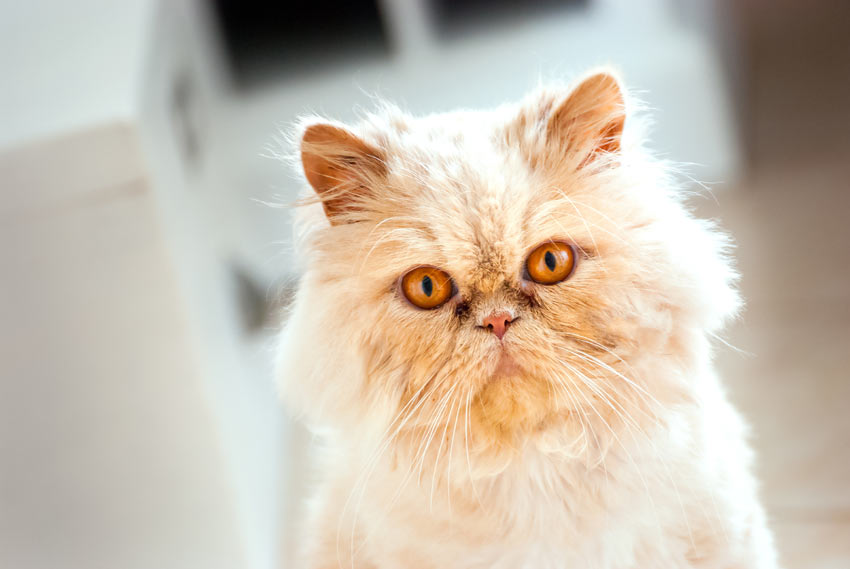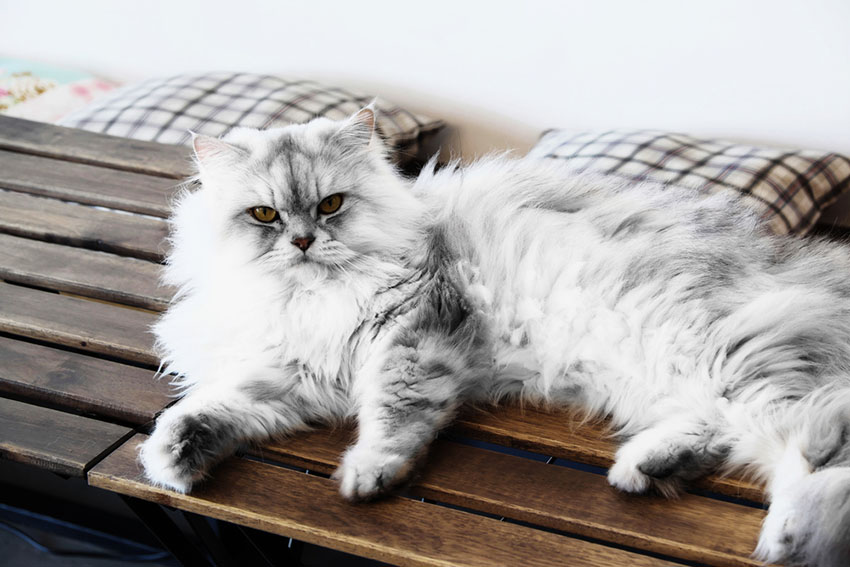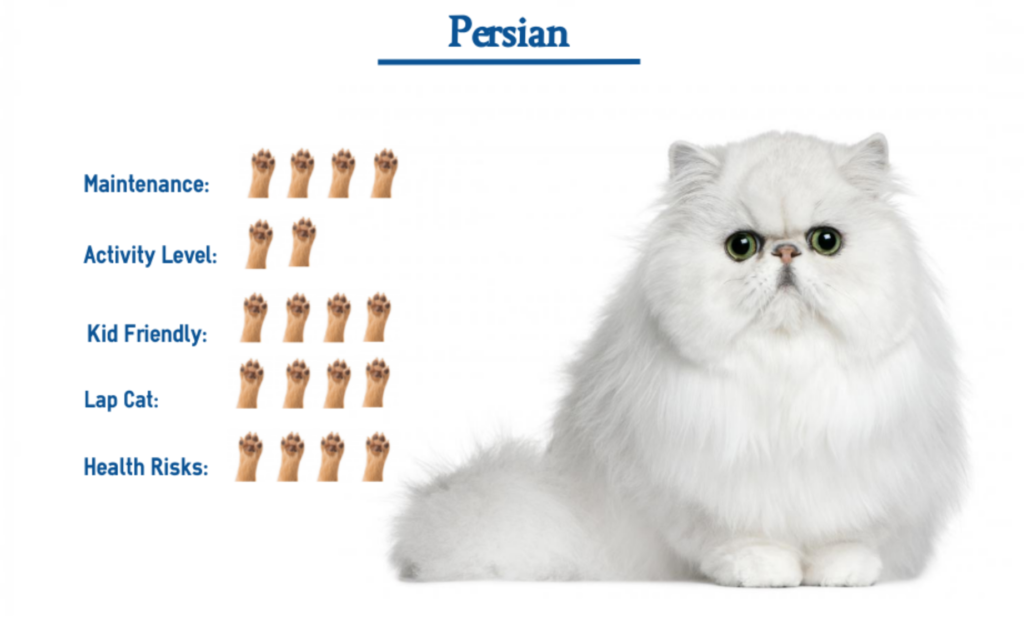Are you a cat lover? Specifically, do you have a soft spot for Persian cats? These fluffy felines are known for their luxurious coats and regal appearance, making them a popular choice among cat enthusiasts. But which Persian cat breed is right for you? In this article, we’ll delve into the different types of Persian cats, their temperament, grooming needs, and more. By the end, you’ll have a clearer idea of which Persian cat breed is the purrfect fit for you.
When it comes to choosing the right Persian cat breed, there are a few factors to consider. First, there’s the Persian Himalayan, also known as the Colorpoint Persian. With their striking blue eyes and point coloration similar to that of Siamese cats, they are an eye-catching choice. Then we have the Exotic Shorthair, a breed that shares many characteristics with the Persian but has a shorter coat, making grooming a bit easier. Another option is the Chinchilla Persian, known for its silver-white coat that shimmers like precious metal. And let’s not forget about the Doll Face Persian, which maintains the traditional Persian look without the extreme facial features found in some show lines.
In this article, we’ll explore the traits and characteristics of each Persian cat breed, helping you make an informed decision. Whether you’re looking for a Persian cat with a sweet and docile nature or one that enjoys playtime and adventure, we’ve got you covered. So, stay tuned to “http://persiancatdude.com” for an in-depth look at the different Persian cat breeds and find the one that will make your heart melt and your home complete.
Choosing the Right Persian Cat Breed for You
Choosing the perfect pet for your home is an exciting and important decision. If you’re considering a Persian cat as your furry companion, you’re in for a treat. Persian cats are known for their exquisite beauty, charming personalities, and long history. However, with various Persian cat breeds and variations available, it’s crucial to choose the right one that suits your lifestyle and preferences. In this article, we will explore the different Persian cat breeds, their characteristics, and tips for selecting the ideal one for you.

Origins of the Persian Cat
The Persian cat breed has a rich history that dates back to ancient times. While the exact origin is unknown, it is believed that Persian cats originated in Persia (modern-day Iran) and were highly revered by nobles and royalty. These luxurious feline companions were introduced to Europe in the 17th century and quickly gained popularity for their unique beauty and gentle nature.
Introduction to the Persian Cat Breed
Persian cats are known for their distinct features, including their long, flowing coats, round faces, and captivating eyes. They have a sweet and calm temperament, making them ideal companions for individuals and families alike. Persian cats are often described as gentle, affectionate, and laid-back.

Evolution of the Persian Cat Breed
Over the years, Persian cats have evolved into several distinct breeds, each with its own characteristics and traits. Some popular Persian cat breeds include the Himalayan, Exotic Shorthair, and Chinchilla Persian. These breeds have been developed by selectively breeding Persians with specific traits, resulting in variations in coat color, length, and facial structure.
Characteristics of Persian Cats
Physical Appearance of Persian Cats
One of the most striking features of Persian cats is their long, luxurious coat. Persian cats have a dense and silky coat that requires regular grooming to prevent matting. They come in various colors and patterns, including solid, tabby, calico, and bi-color. Along with their majestic coats, Persian cats have round faces, small ears, and large, expressive eyes.
Coat Types and Colors in Persian Cats
Persian cats can have either a traditional doll-face or a more contemporary flat-face. The doll-face Persian has a more natural facial structure, while the flat-face Persian has a flatter face and a shorter nose. When it comes to coat colors, Persian cats have a wide range of options, including white, black, blue, cream, and many more.
Temperament and Personality Traits of Persian Cats
Persian cats are known for their calm and affectionate nature. They enjoy spending time with their human companions, but they are also content to relax and nap quietly. These cats are not particularly demanding or high-energy, making them suitable for individuals and families who prefer a more laid-back pet.

Caring for a Persian Cat
Owning a Persian cat requires certain considerations when it comes to their care and wellbeing. Here are some essential aspects to keep in mind:
Feeding and Nutrition for Persian Cats
Proper nutrition is crucial for maintaining a Persian cat’s health and beauty. Persian cats should be fed a balanced diet that includes high-quality cat food rich in protein and essential nutrients. It is important to avoid overfeeding, as Persian cats are prone to weight gain. Consult with your veterinarian to determine the right feeding routine and portion sizes for your cat.
Grooming and Bathing a Persian Cat
The beautiful, long coat of a Persian cat requires regular grooming to keep it clean and tangle-free. Daily brushing is necessary to prevent matting and hairballs. Additionally, monthly bathing is recommended to maintain their coat’s pristine condition. Investing in the proper grooming tools and establishing a grooming routine from a young age will ensure your Persian cat stays healthy and comfortable.
Exercise and Playtime for Persian Cats
While Persian cats are not as active as some other breeds, they still require regular exercise to stay fit and mentally stimulated. Interactive toys, scratching posts, and play sessions with their human companions are excellent ways to provide exercise and enrichment. However, it is important to note that Persian cats are indoor cats and should be kept safe from outdoor hazards.
Health Considerations for Persian Cats
As with any breed of cat, Persian cats are prone to specific health issues. Understanding these concerns and taking proactive measures can help ensure your Persian cat lives a long and healthy life.
Common Health Issues in Persian Cats
Persian cats are susceptible to respiratory problems, dental issues, and eye conditions. Their facial structure makes them prone to tear duct obstruction, leading to tear staining and potential infections. Additionally, Persian cats can experience polycystic kidney disease, hypertrophic cardiomyopathy, and other genetic conditions. Regular veterinary check-ups and preventive care are essential for identifying and addressing any health issues early on.
Preventive Care and Regular Veterinary Check-ups
To keep your Persian cat in optimal health, regular visits to the veterinarian are crucial. Vaccinations, flea and tick prevention, dental cleanings, and parasite control are all part of a comprehensive preventive care plan. Your veterinarian can also provide guidance on feeding, grooming, and any breed-specific health concerns.
Understanding Allergies in Relation to Persian Cats
While Persian cats are known for their low shedding, no cat is truly hypoallergenic. People with allergies to cats may still experience symptoms when around Persian cats. It is advisable to spend time with a Persian cat before bringing one into your home to gauge any potential allergic reactions.

Choosing a Persian Cat Breeder
When considering adding a Persian cat to your family, it is essential to find a reputable breeder who prioritizes the health and well-being of their cats. Here are some steps to guide you in choosing the right Persian cat breeder:
Researching Reputable Persian Cat Breeders
Research and gather information about different Persian cat breeders in your area. Look for breeders who have a good reputation, prioritize the health and temperament of their cats, and provide a loving and clean environment for their animals. Online reviews, recommendations from trusted sources, and visiting cat shows can also help you identify reputable breeders.
Visiting a Breeder’s Facility
Visit the breeder’s facility to assess the living conditions and meet the cats firsthand. A reputable breeder should be open to answering questions and providing information about their breeding practices, health screening, and socialization efforts. Observe whether the cats appear healthy, happy, and well-cared for.
Evaluating the Health and Quality of Persian Cats
When visiting a breeder, pay attention to the overall health and quality of the Persian cats. Look for signs of good physical condition, including bright eyes, clean ears, and shiny coats. Ask the breeder about any health issues within their breeding lines and request health certificates or genetic testing results for the cats.
Preparing Your Home for a Persian Cat
Before bringing home your new Persian cat, it’s important to prepare your home to ensure a safe and comfortable environment. Here are some steps to follow:
Creating a Safe and Comfortable Environment
Persian cats thrive in a calm and quiet environment. Provide a designated space for your cat, complete with a cozy bed, scratching post, and toys. Ensure that your home is free of hazards such as toxic plants, open windows, and inaccessible areas that could pose a danger to your cat.
Choosing the Right Supplies and Equipment
Invest in essential supplies and equipment for your Persian cat, including food and water bowls, a litter box with low sides for easy access, and a selection of toys for mental stimulation. Additionally, consider purchasing a cat tree or perching shelves to provide vertical space for your cat to explore and relax.
Introducing Your Persian Cat to Your Home
When bringing your Persian cat home, make the transition gradual and stress-free. Set up a small space initially, such as a separate room, and gradually introduce your cat to different areas of your home. Allow your cat to adjust at their own pace, providing plenty of love, reassurance, and positive reinforcements.
:strip_icc()/GettyImages-904624038-8a3d9763601742258dd48df05e1ce69f.jpg)
Training and Socializing a Persian Cat
Training and socializing your Persian cat from an early age will help them become well-rounded and well-behaved companions. Here are some essential training tips:
Basic Training Tips for Persian Cats
Persian cats are intelligent and can be taught basic commands and tricks. Use positive reinforcement techniques, such as treats and praise, to reward desired behaviors. Be patient and consistent in your training efforts, and always remember to keep the sessions short and enjoyable.
Teaching Good Behavior and Litter Box Training
Proper litter box training is essential for Persian cats. Show them the location of the litter box and encourage them to use it consistently. Reward them with treats and praise when they use the litter box correctly. Additionally, establish boundaries and discourage unwanted behaviors such as scratching furniture or jumping on countertops using gentle redirection and positive reinforcement.
Socializing Your Persian Cat with Other Pets
If you have other pets in your home, it is important to properly introduce and socialize them with your Persian cat. Take gradual steps and provide supervised interactions, ensuring a positive and safe environment for all animals involved. Consult with a professional animal behaviorist if needed.
Persian Cats and Family Life
Persian cats can make wonderful family pets and are generally well-suited for households with children and elderly individuals. However, there are a few important considerations to keep in mind:
Persian Cats as Family Pets
Persian cats are known for their gentle and affectionate nature, making them excellent companions for individuals and families. However, it is crucial to teach children to treat them with respect and gentleness. Supervision is important to ensure the well-being of both the cat and children.
Interactions with Children and Elderly
Always supervise interactions between Persian cats and young children or elderly individuals. Teach children to approach the cat calmly and gently, avoiding rough handling. Likewise, ensure that elderly individuals are able to provide the necessary care and attention required for a Persian cat, including grooming and veterinary visits.
Managing Allergies and Family Members
If anyone in your household has allergies to cats, it is important to consider the potential impact of bringing a Persian cat into your home. Discuss allergy management strategies with your family members and consider consulting an allergist for guidance.
Showing and Exhibiting Persian Cats
If you are interested in showcasing the beauty and elegance of your Persian cat, participating in cat shows and exhibitions can be a rewarding experience. Here’s what you need to know:
Understanding Cat Shows and Competitions
Cat shows and competitions provide a platform for breeders and owners to showcase their Persian cats and be recognized for their quality and beauty. These events feature various categories and judging criteria to evaluate the cats’ conformation, coat condition, and temperament.
Preparing Your Persian Cat for a Show
Preparing your Persian cat for a show involves meticulous grooming, conditioning, and training. Regular grooming sessions to maintain the coat’s quality and appearance are crucial. Additionally, acclimate your Persian cat to the show environment by gradually exposing them to the sights, sounds, and handling they will encounter during the event.
Judging Criteria for Persian Cat Exhibitions
Persian cats are judged based on specific criteria, including head structure, coat quality, eye color and shape, and overall balance and symmetry. Judges also evaluate the cat’s temperament, looking for a calm and friendly disposition. Understanding the judging process can help you prepare your Persian cat and enhance your chances of success in the show ring.
Rescuing and Adopting a Persian Cat
Another option for adding a Persian cat to your family is rescuing or adopting one. Here are some benefits and considerations:
Benefits of Rescuing a Persian Cat
Rescuing a Persian cat can be a rewarding experience, as you are providing a loving home to a cat in need. Many rescue organizations and shelters have Persian cats available for adoption, offering an opportunity to give a second chance to a deserving cat.
Finding Persian Cats for Adoption
Research local rescue organizations, animal shelters, and breed-specific rescue groups to find Persian cats available for adoption. These organizations often evaluate the cat’s health and temperament before placing them in new homes. Adoption fees typically cover the cat’s veterinary care, vaccinations, and spaying/neutering.
Adapting a Rescued Persian Cat into Your Home
When bringing a rescued Persian cat into your home, be patient and understanding. These cats may have experienced trauma or neglect, requiring time to adjust to their new surroundings. Provide a calm and nurturing environment, and consult with the rescue organization or a professional behaviorist for guidance on helping the cat settle in comfortably.
Persian Cat Breeds and Variations
In addition to the traditional Persian cat breed, there are several variations and sub-breeds that offer unique characteristics. These variations include:
Popular Persian Cat Breeds
The Himalayan cat, also known as the Colorpoint Persian, is a crossbreed between the Persian cat and the Siamese cat. This breed combines the Persian’s luxurious coat with the Siamese’s color points. The Exotic Shorthair, often referred to as the “shorthaired Persian,” has a similar appearance to the Persian but with a shorter, more manageable coat.
Rare and Unique Persian Cat Variations
The Chinchilla Persian is known for its striking silver coat and green or blue-green eyes. The Silvershade Persian has a dazzling coat color pattern, with a white undercoat and black tipping on the outer fur. The Smoke Persian features a solid-colored undercoat with the same colored tipping, creating a beautiful smoky effect.
Understanding the Differences between Persian Cat Breeds
Each Persian cat breed and variation has its own unique characteristics and traits. Whether it’s the traditional Persian, the Himalayan, the Exotic Shorthair, or one of the rarer variations, it’s important to research and understand the specific breed’s care requirements and temperamental traits to find the perfect match for you.
Famous Persian Cats in History and Pop Culture
Persian cats have made their mark in history and popular culture, leaving a lasting impression. Here are a few notable examples:
Iconic Persian Cats in Art and Literature
Persian cats have been featured in various works of art and literature throughout history. They have graced the pages of classic novels, such as “Alice’s Adventures in Wonderland” by Lewis Carroll, and have been depicted in beautiful paintings by renowned artists.
Persian Cats in Movies and Television
Persian cats have also made appearances in movies and television shows, often portrayed as elegant and regal characters. They have become symbols of luxury and sophistication in popular culture.
Celebrity-Owned Persian Cats
Several celebrities have chosen Persian cats as their beloved companions. These high-profile figures have showcased their Persian cats on social media, bringing more attention and adoration to the breed.
Experiences and Stories from Persian Cat Owners
Owning a Persian cat comes with its own set of unique experiences and stories. Persian cat owners often find joy in the special bond they form with their feline companions. Here are a few examples:
Heartwarming Stories of Persian Cat Companionship
Persian cats are known for their loyalty and affectionate nature, providing endless love and comfort to their owners. Many owners have heartwarming stories of how their Persian cats have brought joy and companionship into their lives.
Memorable Moments with Persian Cats
Owning a Persian cat is full of memorable moments, from their playful antics to their loving gestures. Whether it’s a cozy cuddle session or a humorous playtime, these cherished moments create lasting memories for owners.
Challenges and Rewards of Owning a Persian Cat
While Persian cats offer many rewards as pets, there can also be challenges. Owners may encounter grooming difficulties, health issues, or the need for extra maintenance due to the Persian cat’s long coat. However, the love and companionship provided by these majestic cats far outweigh any challenges.
Conclusion
When choosing a Persian cat, it’s important to consider factors such as breed variations, personality traits, and care requirements. By understanding the different Persian cat breeds and variations, as well as the responsibilities of cat ownership, you can make an informed decision and find the perfect Persian cat companion for you. Whether you opt for a traditional Persian, a Himalayan, an Exotic Shorthair, or one of the unique variations available, a Persian cat is sure to bring beauty, grace, and endless love into your life.
FAQs about Persian Cats:
- What is the lifespan of a Persian cat?
- On average, Persian cats live between 12 to 15 years. However, with proper care and regular veterinary check-ups, some Persian cats can even live into their late teens or early twenties.
- Are Persian cats hypoallergenic?
- While Persian cats are known for their low shedding, no cat is completely hypoallergenic. People with allergies to cats may still experience symptoms when around Persian cats. It is recommended to spend time with a Persian cat before bringing one into your home if you or a family member has allergies.
- Do Persian cats require a lot of grooming?
- Yes, Persian cats have long and luxurious coats that require daily grooming to prevent matting and tangling. Regular brushing, monthly baths, and keeping the coat clean are essential for their overall health and appearance.
- Are Persian cats good with children?
- Persian cats are generally gentle and good-natured, making them suitable companions for children. However, it is important to teach children to treat the cat with respect and gentleness, and to supervise interactions between the cat and young children.
- Can Persian cats live in apartments?
- Yes, Persian cats can adapt well to apartment living. They are typically low-energy cats, making them well-suited for indoor environments. Providing them with adequate play and exercise opportunities, as well as a comfortable living space, is important for their well-being.
- Are Persian cats high-maintenance?
- Persian cats do require some extra maintenance due to their long coats and potential health issues. Regular grooming, including daily brushing, monthly baths, and eye cleaning, is necessary. Additionally, regular veterinary check-ups and quality nutrition are important for their overall health.
- Are Persian cats vocal?
- Persian cats are generally not known for being particularly vocal compared to some other breeds. However, each cat has its own personality, and some Persian cats may be more talkative than others.
- Can Persian cats live with other pets?
- Persian cats can live harmoniously with other pets, including dogs and other cats, with proper introductions and gradual socialization. It is important to supervise interactions and provide a safe and positive environment for all animals involved.
- Do Persian cats require a specific diet?
- Persian cats should be fed a balanced and high-quality cat food that meets their nutritional needs. Consult with your veterinarian to determine the best diet and feeding routine for your specific Persian cat.
- Are Persian cats indoor or outdoor cats?
- Persian cats are generally indoor cats. Their long coats require protection from outdoor hazards, and their calm nature makes them less likely to roam far from home. Providing them with a safe and enriching indoor environment is key to their well-being.